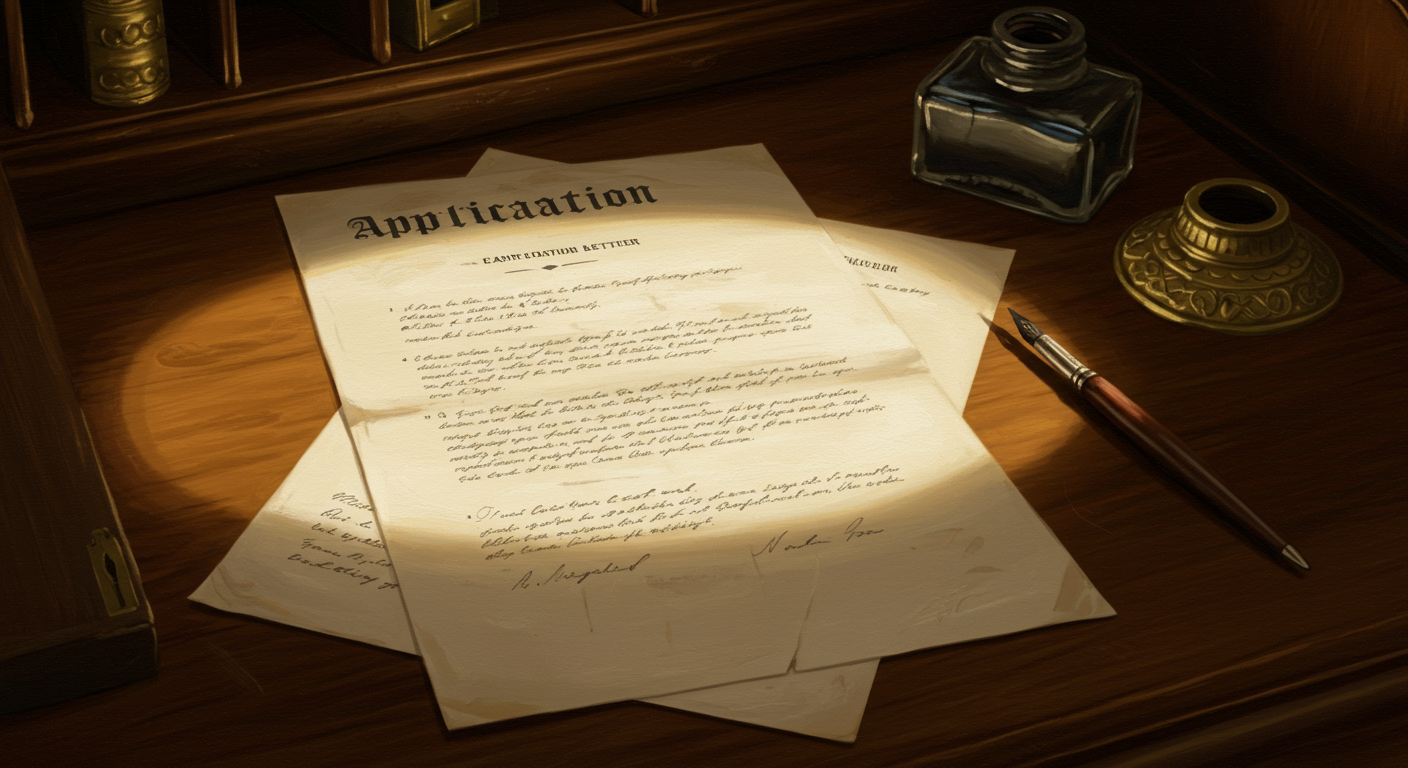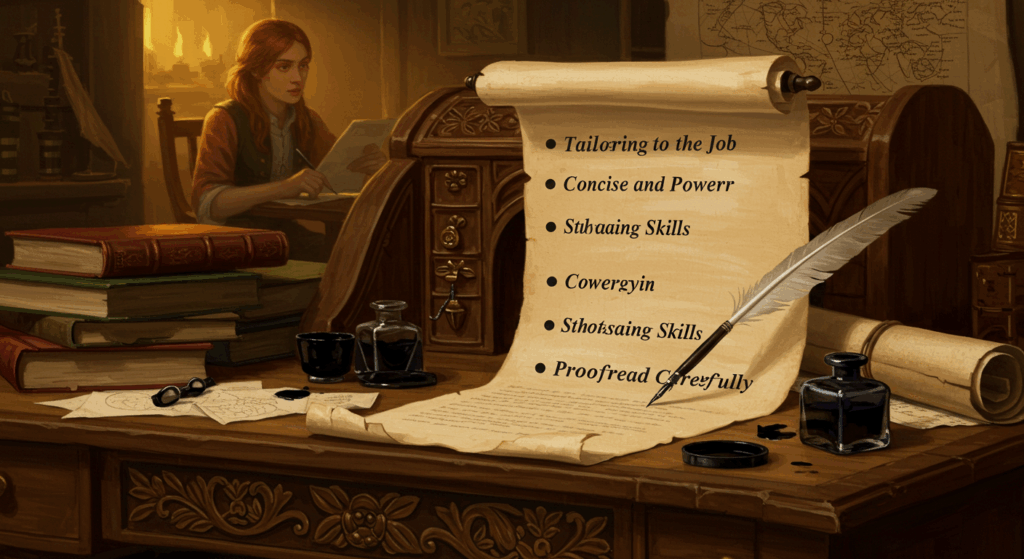Cover letters feel like the essay you thought you left behind in school. You open a blank doc, stare at the cursor, and suddenly your brain is playing elevator music. Meanwhile, the job post is whispering “just write something” and you’re like… something what, exactly?
Take a breath. You don’t need to be Shakespeare, you just need to sound like a clear, capable human who understands what the company wants and how you can help. This beginner-friendly guide will walk you from a blank page to a solid draft—step-by-step, with friendly tips, quick introduction pointers, and the most common mistakes to avoid. No corporate robots here; we’re writing like real people (with coffee).
Introduction: What a Cover Letter Actually Does (and What It Doesn’t)
Let’s rewrite the job-hunt myth: a cover letter is not a place to retype your entire resume. It’s the introduction to you—the quick “hey, here’s why I’m a strong fit and how I’ll deliver value” moment. Think of it as a movie trailer for your application: short, relevant, and convincing.
What it does:
- Shows you can communicate clearly (big green flag).
- Connects your experience to their problems or goals.
- Adds context to anything your resume doesn’t explain (career switch, gaps, unusual path).
- Demonstrates personality—within professional boundaries (sprinkle, don’t dump).
What it doesn’t do:
- List every job ever (that’s your resume).
- Use generic fluff like “hard-working team player” 17 times.
- Overwhelm the reader with walls of text. Ngl, nobody’s got time.
The Quick Anatomy of a Great Cover Letter (TL;DR)
Before we get fancy, here’s the structure that works for almost anyone:
- Header: Your name and contact info. Then the hiring manager’s name, title, company, and date. Keep it clean.
- Greeting: “Dear [Name],” > “To Whom It May Concern.” If you can’t find a name, “Dear Hiring Manager,” is fine.
- Opening (your introduction): Hook them with somwthing specific to the company or role. Show you did 5 minutes of research.
- Middle (2 short paragraphs max): Tie your achievements to their needs. Show proof: metrics, projects, outcomes.
- Closing: Reaffirm your fit, invite next steps, and sign off politely. Optional: a short P.S. with a spicy little extra value.
That’s it. One page. Tight, hunman, helpful.
Start Strong: The Kind of Introduction That Makes Them Keep Reading
Your introduction doesn’t have to be a TED Talk. It just needs to be specific and confident. Compare:
- Meh: “I’m writing to apply for the Marketing Assistant role at Company X.”
- Better: “I’m excited to apply for the Marketing Assistant role at Company X; your recent launch of the student plan caught my eye—especially how you used micro-creators to reach campus audiences. That’s exactly the kind of campaign I’ve been building.”
See the difference? The second opening signals “I get you.” That’s the goal.
Tips for your opening:
- Mention something real about the company (a product update, campaign, value, or mission note).
- State your role and 1–2 relevant strengths.
- Keep it under 3 sentences. Short is powerful.
Tips That Make Recruiters Pause Their Scroll
Here’s the snackable tips section—bookmark it, tattoo it, stick it on your fridge:
- Mirror the job post (but with your words). If the post asks for “community building” and “email campaigns,” talk about your community project and your email results. It’s not cheating; it’s alignment.
- Quantify, even small wins. “Increased open rates from 22% to 34%,” “handled 80+ support tickets/week,” “cut onboarding time by 15%.” Numbers are catnip.
- Use plain language. If your friend wouldn’t understand it, it’s too jargon-y. Keep it clear and warm.
- One page, white space, readable font. This is not the time for 9-point fonts and block paragraphs. Think 10–12pt and 3–5 paragraphs max.
- Customize lightly. You don’t need a whole new letter each time. Keep a strong base and swap 20–30% for each role.
- Add a tiny story. One sentence that reveals how you think or work (“When a campaign underperformed, I ran a quick survey and pivoted messaging to student savings—CTR doubled in 10 days.”).
- P.S. hack (optional). Add a postscript with a relevant link (“P.S. Here’s a 90-second Loom demo of the analytics dashboard I built—happy to walk through it.”). P.S. lines actually get read.
Common Mistakes (And Easy Fixes)
Let’s save you from the cringe. These common mistakes happen all the time:
- Mistake: Generic fluff. “I’m a detail-oriented team player.”
Fix: Replace with proof (“I managed a 5-person volunteer team and delivered 100% of tasks on-time for 6 months.”). - Mistake: Rewriting your resume.
Fix: Pick 1–2 resume highlights and connect them directly to the job’s needs. - Mistake: Passive voice.
Fix: Use active verbs: built, led, increased, designed, shipped, resolved. - Mistake: Too long.
Fix: ~250–400 words. Use short paragraphs. Delete filler words (very, really, quite). - Mistake: Typos (ugh).
Fix: Read it out loud. Run spellcheck. Ask one human to review. Then re-check names/titles (so many oops-es happen here). - Mistake: Vibes mismatch.
Fix: If the brand sounds playful, you can be warm. If it’s more formal, aim for crisp and respectful.
Write It With Me: A Simple Template You Can Steal
Feel free to copy-paste this into your doc and personalize. It has a clear introduction, value-driven middle, and a clean clowse.
Your Name
City, ST • email@domain.com • (123) 456-7890 • LinkedIn | Portfolio
Date
Hiring Manager Name
Title
Company Name
Company Address (optional)
Dear [Hiring Manager Name],
I’m excited to apply for the [Role Title] at [Company]. Your [specific initiative/product/value—something real] stood out to me, especially because I’ve [relevant experience or interest]. I’d love to help [Company] [reach a goal you can contribute to].
In my recent experience at [Previous Company/Project], I [what you did], which led to [quantified outcome]. I also [second relevant thing], improving [metric] by [number or %]. I’m comfortable with [tools/skills the job mentions], and I like to back my work with data and quick feedback loops.
What draws me most to [Company] is [genuine reason—mission, users, tech, design approach]. I see a strong overlap between your needs—[one or two needs from the job post]—and what I do well: [two short strengths]. I’m confident I can ramp quickly and contribute to [team or goal] in my first 90 days.
Thanks for considering my application. I’d be glad to share more details or walk through relevant work samples. Looking forward to the possibility of contributing to [Company].
Best regards,
[Your Name]
P.S. Here’s a quick link to [portfolio piece / 60–90s demo] relevant to [their need].
Example 1: Entry-Level Applicant (No Fancy Titles Yet)
Scenario: You’ve had internships, school projects, or part-time gigs. Still totally valid.
Sample letter:
Dear Ms. Alvarez,
I’m excited to apply for the Junior Content Creator role at GlowUp. Your recent college-ambassador program for affordable skincare really clicked with me—I ran a student-led campaign for a local brand and learned how to turn feedback into content that actually lands.
At Re:Campus, I co-wrote 15 blog posts and 30+ Instagram captions that helped raise engagement from 2.1% to 4.5% over two months. I also built a simple Notion calendar to coordinate student creators across three campuses (we hit 95% on-time posting, which, trust me, was a miracle during finals week). I’m comfortable with Canva, basic Figma, and I’ve dabbled in short-form video (3 reels hit 10k+ views organically).
I’m drawn to GlowUp’s supportive tone and the way you pair skincare science with approachable content. I’d love to help amplify that voice for Gen Z and early-career users, especially on TikTok and your blog.
Thanks for your time—I’d love to share writing samples or brainstorm quick ideas for your fall launch.
Best,
Ari
P.S. Here’s a 1-minute video breakdown of how we turned student Q&As into a content series.
What Worked (tips):
- Clear introduction with company-specific detail.
- Concrete outcomes (2.1% → 4.5%).
- Tools listed briefly.
Avoided common mistakes: not rehashing the resume, not vague.
Example 2: Career Switch (Retail → Customer Success)
Scenario: You’ve got people skills; you’re moving into a SaaS role.
Dear Hiring Manager,
I’m applying for the Customer Success Associate role at BrightDesk. I’ve followed your growth in the hybrid-work space, and your focus on helping small teams adopt project tracking tools is basically my happy place.
For three years at Sunnyside Retail, I was the person customers looked for when something broke or got confusing. I handled 70–100 customer interactions per shift, kept our CSAT above 95%, and trained five new hires on troubleshooting. I also created a simple Google Sheet to track recurring issues; our manager used it to update the FAQ and reduce repeat problems by ~20%.
I’m transitioning into SaaS because I love turning “I’m stuck” into “I’ve got this,” especially with tools that make teams feel calmer and more organized. BrightDesk’s onboarding videos already show that vibe. I’d be excited to help new users get quick wins in their first week and reduce ticket volume with step-by-step guides.
Thanks for considering my application—I’d be happy to walk through how I’d approach your onboarding checklist.
Best regards,
Maya
Why It Works (tips):
- Transferable skills highlighted.
- Metrics matter even outside tech.
- Introduction ties personal motivation to the company.
Avoided common mistakes: didn’t apologize for switching careers; focused on value.
Example 3: Internship (Student With Projects)
Dear Mr. Lee,
I’m applying for the Product Design Intern role at Finch. Your focus on accessibility and calm UX is exactly what I’ve been studying (and lowkey ranting about) this semester.
In my capstone project, I led the design of a medication-reminder app for older adults. I ran five user interviews, built wireframes in Figma, and tested three iterations; our final prototype improved task completion from 62% to 88% in usabillity testing. I also interned at a student startup where I created onboarding flows and learned how to politely fight for whitespace.
Moreover, I admire Finch’s commitment to accessible color contrast and readable typography. I’d love to support the design team this summer—whether that’s building components, writing UX copy, or documenting patterns in your library.
Thanks for your time. I’ve attached a one-pager with visuals and can demo the prototype if helpful.
Best,
Noah
Strong parts (tips):
- Introduction shows research.
- The story uses outcomes and process, not just “I designed a thing.”
Common mistakes avoided: no braggy jargon, no “I’m just a student” energy.
Formatting Basics So Humans (and ATS) Will Like You
Before you send, the packaging matters. Not scary, promise.
- Length: Aim for ~300–450 words. Under a page.
- Font: Simple—Calibri, Georgia, Helvetica, Arial. 10.5–12 pt.
- Spacing: 1.0 or 1.15. Space between paragraphs.
- File type: PDF unless the posting asks for something else.
- Naming:
Firstname-Lastname-Cover-Letter-Role-Company.pdf. - Alignment: Left-aligned. Keep margins at ~1 inch.
- Header match: Make your resume header and cover letter header consistent. It’s a tiny brand move.
How to Personalize Without Spending 6 Hours
You don’t need to fall down a research rabbit hole. Try the 10–10–10 method (it’s not a TikTok dance, sadly):
- 10 minutes: Company scan. What do they sell? Who are the users? Any recent announcement?
- 10 minutes: Job post highlights. Bold the top 3 responsibilities and the top 3 skills.
- 10 minutes: Your match. For each responsibility, write one sentence of how you’ve done something similar (with numbers or outcomes). Boom—there’s your middle paragraph.
Tips for easy customization:
- Swap the company-specific lines in your introduction.
- Change 1–2 achievements to match their top needs.
- Add a relevant P.S. link (portfolio, demo, short case study).
This keeps quality high without burning your weekend.
Handling Gaps, Switches, or “No Experience”
Life happens. Recruiters know that. Here’s how to frame it:
Gaps
- Keep it simple: “After a planned sabbatical to care for family/complete a course, I’m excited to return to [field].”
- Emphasize continuous learning (courses, volunteer work, personal projects). That’s a proactive signal.
Career Switch
- Focus on transferable skills (communication, problem-solving, training, data, project management).
- Use the job’s language and match your experience to it.
- Share one story that shows you’ve already done the work, even informally (e.g., “I set up a Notion board for a club that doubled event attendance in two months.”).
“No Experience”
- You do have experience; it just might not be paid. Use class projects, hackathons, clubs, volunteer roles, freelancing, personal builds.
- Quantify the outcome, not the title.
Email vs. Attachment, and Other FAQs
Do I always need a cover letter?
Not always, but if the posting mentions one or the company is competitive, it helps. If you’re light on experience or switching fields, it’s especially valuable. (Yes, still keep it short.)
Email body or attached PDF?
If you’re applying by email, you can paste a slightly condensed version in the email body and attach the full PDF. If it’s an application portal, upload the PDF.
Do I repeat my resume?
Nope. Your letter should connect the dots and add context. Treat it like a highlight reel + commentary.
How long should it be?
Think 3–5 paragraphs, 250–450 words. Leave breathing room.
Can I be casual?
Match the brand. If they sound fun online, you can be friendly. If they’re serious, keep it crisp with a hint of warmth.
Proofreading Checklist (Avoiding Common Mistakes)
Yes, yes—spellcheck is basic. But the tiny stuff is what gets you. Use this quick pass to dodge common mistakes:
- Names and titles spelled 100% correctly. (Triple-check. Then check again. Pls.)
- Role and company match the posting.
- One-page length, short paragraphs.
- At least one quantified outcome.
- No generic filler (very, highly, extremely, passionate about passion).
- The introduction is customized (mentions something real about the company).
- The tips you followed: plain language, focus on value, relevant tools.
- Save as PDF with a clean file name.
If You’re Using AI (Like Me), Do It Safely
AI is the buddy who helps brainstorm—not the ghostwriter who steals your voice. A few quick tips:
- Ask AI for structure, bullet points, or phrasing ideas—then rewrite with your voice.
- Feed it your real achievements and numbers (don’t let it invent things).
- Run any AI-generated line through your “would I say this out loud?” test.
- Stick to your truth. Overclaiming is a common mistake and it backfires in interviews.
A Mini Swipe File: Intros, Bridges, Closings
Steal these lines and tweak them, like a playlist you keep remixing.
Intros (introduction inspo)
- “I’m excited to apply for [Role] at [Company]; your [campaign/product/mission] stood out to me because [reason].”
- “When I saw your focus on [user/problem], I immediately thought of [experience] where I [impact].”
Bridges (move from intro to proof)
- “Here are two ways I can contribute from day one:”
- “A quick look at how I’ve tackled similar work:”
Closings
- “I’d love to share a brief walkthrough of [relevant project] if helpful.”
- “Thanks for your time—looking forward to the possibility of contributing to [Company].”
- “P.S. Here’s a 60-second demo of [thing], relevant to [their need].”
A Simple Practice Exercise (10 Minutes, Promise)
- Copy the template above.
- Spend 10 minutes researching the company and job post.
- Write a 2–3 sentence introduction that includes one specific detail.
- Add two short proof points with numbers (even estimates are okay if truthful).
- Close with one sentence on fit + a polite ask for next steps.
- Proofread using the checklist.
Done. You now have a real-deal letter, not a generic blob.
Wrap-Up: You’ve Got This (Really)
Writing a cover letter doesn’t require magic—just clarity, a bit of company-sprecific detail, and proof that you can deliver. Use the template, skim the tips, avoid the common mistakes, and let your voice through (lightly! we’re not doing slam poetry). Your introduction sets the tone; your examples sell the fit; your closing opens the door.
Open a doc, pick a role, and try the 10–10–10 method right now. Draft messy. Trim it down. Add one number. Hit save. You’re closer than you think.
And yes, you’ve got this—now go write that cover letter and hit submit.









